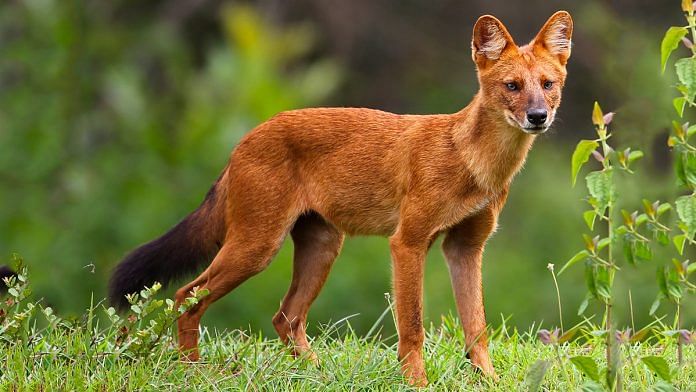Aizawl: Globally, they number fewer than tigers. Legend claims they can overpower tigers. Now, a significant number of dholes, also known as Asiatic Wild Dogs, has been spotted in a tiger reserve where the big cat is believed to be extinct.
An international team of researchers working at the Dampa Tiger Reserve on Mizoram’s western periphery, around 250 km south of the Brahmaputra, say they camera-trapped at least one dhole a day for four months in an area just 80 sq km wide, less than a twelfth of Dampa’s entire breadth.
Their findings were published on 23 October in the journal Fauna and Flora International.
In a paper titled “Conservation status of the dhole Cuon alpinus in north-east India, with a focus on Dampa Tiger Reserve, Mizoram”, authors Priya Singh (of the National Centre for Biological Sciences, Bengaluru), Arjun Srivathsa (University of Florida) and David W. MacDonald (University of Oxford) outlined how they deployed 79 camera-traps in Dampa’s core north-eastern areas between December 2014 and March 2015.
“A total of 5,033 camera-trap days in Dampa Tiger Reserve generated 500 photo-encounters of dholes, comprising 92 detections (one per 24-hour duration) across 33 sites,” they wrote.
The presence of a sizeable number of dholes in Dampa is crucial not just for the species, but for the reserve’s landscape as a whole.
When Dampa was first designated a tiger reserve back in 1994, a census indicated it had four tigers.
Subsequent surveys never again included direct sightings of India’s most treasured protected species, although scat samples — faecal matter — in a 2014 exercise indicated there may still be three tigers left.
In the tiger census released by PM Narendra Modi on 29 July this year, Dampa was marked as having no tigers left.
Dampa has been a known habitat of dholes, but the numbers believed to have been spotted make the study significant. What also makes it important is the long-due focus it brings on a neglected species whose numbers are said to be shrinking.
Endangered predator
Dholes are an endangered predator whose population has shrunk by as much as 80 per cent since the beginning of the 20th century.
A 2015 report by The Guardian described dholes as “surprisingly small”.
“At just 12-18 kilograms, dholes are 30 to 50 per cent the size of your average wolf, making them smaller than many medium-sized dogs,” it added.
It, however, labelled them “‘natural born killers’ in their ability both to tackle large (and often dangerous) prey like sambar deer, boar and young or injured gaurs — wild bovines that can weigh 50 times more than a dhole”.
The legendary hunter Kenneth Anderson once wrote about a pack of dholes allegedly tearing a tigress apart.
However, despite their formidable hunting skills, the International Union for Conservation of Nature (IUCN) estimates there are only 949-2,215 mature dholes across the world, against an estimated 2,154-3,159 adult tigers.
They are the last remaining species within the genus ‘cuon’, which means that if dholes die off, an entire genus can be struck off from the animal kingdom.
According to the IUCN red list of endangered species, the dhole is already extinct in nine Asian countries, from Russia in the north to Afghanistan in the south, and there is little evidence they still exist in North Korea or Pakistan.
However, declining populations still roam the forests of India and some of its eastern neighbours.
Dholes, who are known to eat their prey alive, were for years seen as “vermin” and “pests” until brought under the Wildlife Protection Act 1972.
Even so, they remain a rarely talked-about animal in conservation circles despite their predatory skills and dwindling numbers.
‘Hugely significant’
Lallianpuii Kawlni, a scientist from Mizoram currently based at the Wildlife Institute of India, Dehradun, said this was the first time she had come across a study focused on the state’s dhole population.
“There has been no robust data on dhole populations or activities in Mizoram until this study, so it is hugely significant because of this,” she added.
However, the significance does not end there.
Dampa, she said, is known primarily as a tiger reserve but recent studies on protected primates and smaller cats such as the clouded leopard show the reserve has huge potential.
The dhole study, she stated, added to that potential since they are a neglected species despite being highly endangered.
“It is even more significant because the study shows that the endangered dholes can co-exist with other carnivores if there is plentiful prey,” she said, adding that the biggest threat to Dampa remains the hunting of animals that serve as prey to these carnivores.
If hunting continues, then the possibility of these carnivores preying on domestic animals and stoking human-wildlife conflict may not be far in the future, she said. This, according to her, would only harm the dhole or other predator/carnivore populations in an area that links the forests of South and Southeast Asia.
Also read: How armed forest teams chased a ‘man-eating’ tiger through Ranthambore to save his life



